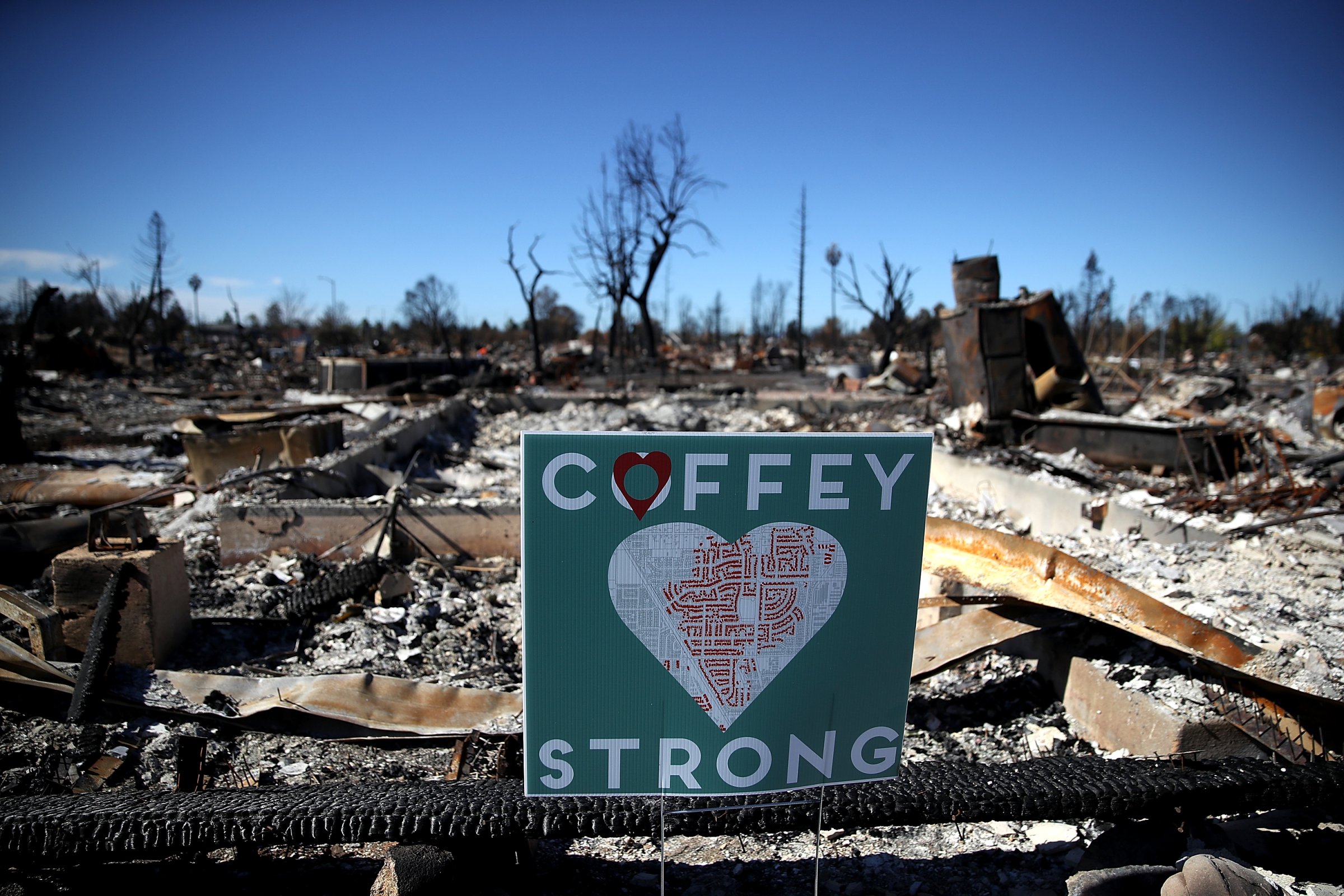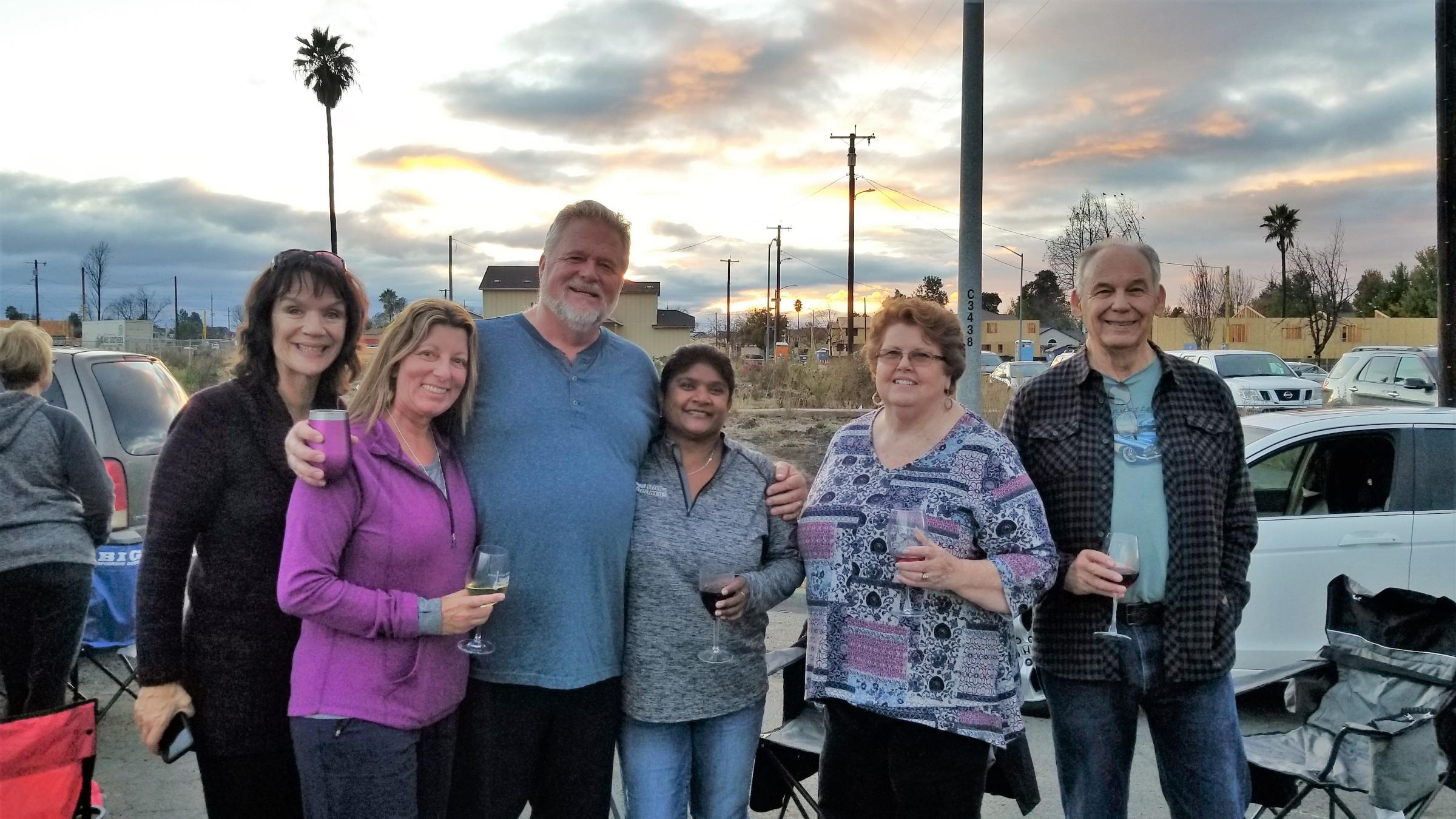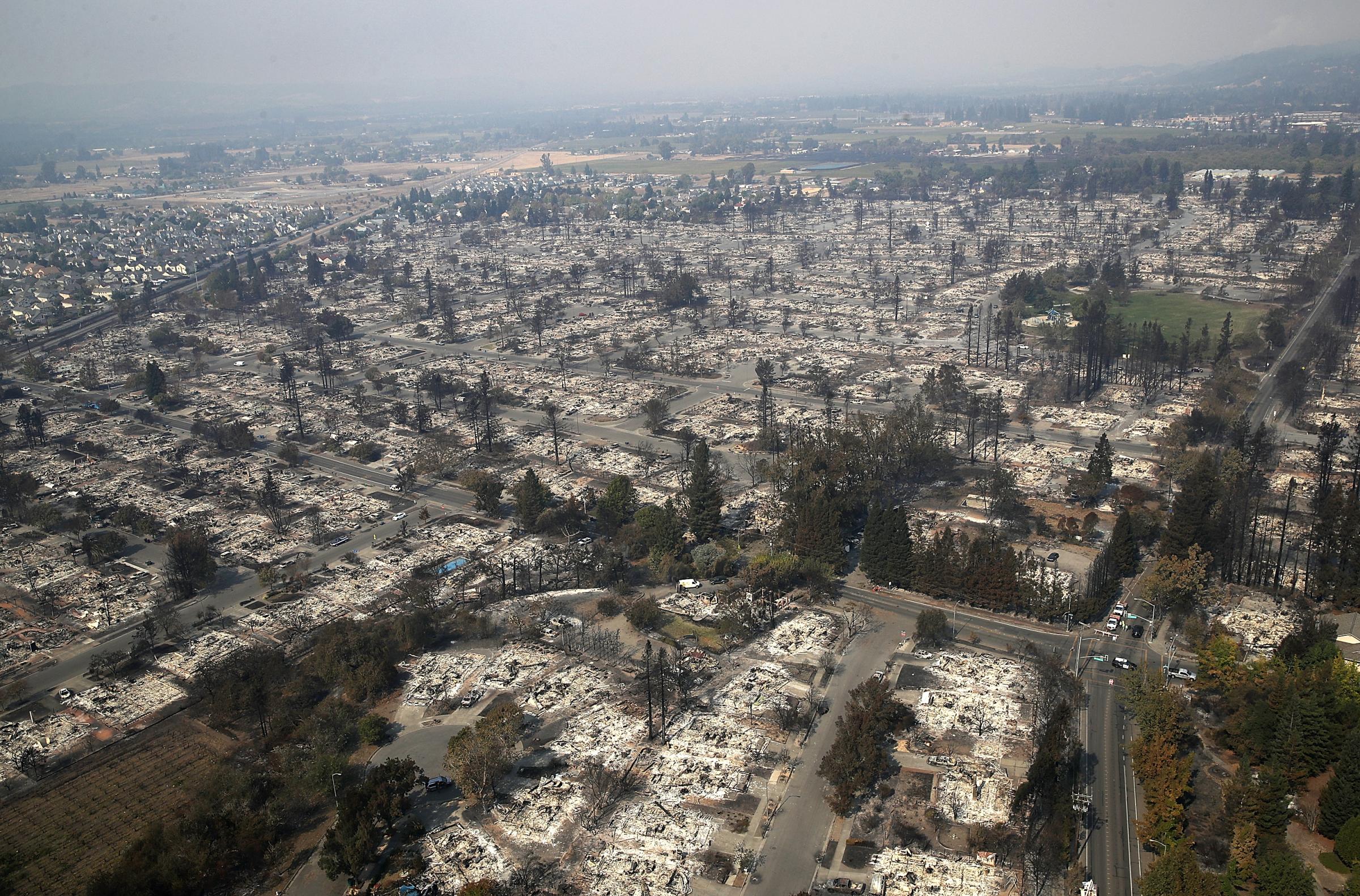
Every Wednesday evening, Tricia Woods pops open a bottle of red wine in the middle of a street where her neighbors’ homes once stood.
Woods is a resident of Coffey Park: a suburban neighborhood filled with family homes and tree-lined cul-de-sacs that was destroyed in October 2017 when a series of aggressive and deadly fires broke out just north of San Francisco. Woods and more than 1,200 of her neighbors lost their homes when the fast-moving fire jumped six lanes of the 101 highway, sending a typically quiet neighborhood scrambling to evacuate and wrestling with a tragedy that would alter their lives and relationships with each other.
So, now, every Wednesday evening, Woods and about 50 of her neighbors eat hotdogs and drink wine in the middle of an empty cul-de-sac off of one of the town’s main roads, commiserating in their loss, complaining about insurance companies, coming in from their various rental homes, and imagining the new neighborhood they are working to rebuild together. The group, known in an official capacity as Coffey Strong, first began as a resource created by and for residents who lost their homes to navigate insurance claims and the rebuilding process. Now, it’s part-nonprofit, part-social club, part-neighborhood collective, part-group therapy.
“It’s my own emotional support group,” says Woods, a single mother and teacher who lost her home in the fire. “Everyone understands the pain, the panic and the stress. It’s a network of people going through the same thing you are — and at the same time.”

Through these efforts, the small neighborhood has quite literally risen from the ashes at a time when Californians grapple with deadlier, faster, and bigger wildfires spanning the state throughout each year. And exactly a year after the fires took hold of these Northern California neighborhoods, the United Nations released a stunning report revealing the disastrous impacts of the rising global temperature — including more frequent and more aggressive wildfires. Neighborhoods like Coffey Park aren’t supposed to burn down like this. Suburban and downtown areas typically sit outside of the state’s “very severe” fire hazard zone — a label determined by California’s Department of Fire and Forest Protection that signals high-risk areas typically in the foothills of arboreous mountains and the area between human-developed land and undeveloped land. But more aggressive wildfire behavior leaves homes in suburban areas more susceptible to a fire’s path — and the pace at which wildfires move makes it difficult for firefighters to provide ample warning and protection to vulnerable homes.
Determining where, when and how to rebuild — or not — hasn’t been on the top of California’s agenda in tackling these more aggressive fires. But scientists say it has just as severe of an impact on the damage these fires cause as the impacts of climate change or the state’s six-year-long drought. After visiting Redding, Calif., in the immediate aftermath of the Carr fire this summer, California Gov. Jerry Brown said the state should “reexamine” “the way we build our houses, where we build them” and “how we build them.”
The issue is even more complicated for neighborhoods within the high-risk zones, like Fountaingrove, an affluent area across the 101 freeway from Coffey Park that also burned in October 2017. Activists pushing for a changed land-use management system in the area as a result of these devastating fires hope Fountaingrove residents, many of whom had larger homes accentuated with beautiful scenery granted from the rolling hills, move to the more urban downtown. But changing a person’s lifestyle — and moving from a mansion to an apartment — isn’t so simple.
“It’s not our place to say you can’t [rebuild],” says Max Moritz, a wildfire specialist at the University of California’s Cooperative Extension. “But as a society we need to have a discussion about how much exposure we feel it’s safe to have our citizens living in.”
Scientists and officials have a different approach: building within already constructed neighborhoods with the looming threat of a fire in mind. “Between climate change and weather and how we can build our communities, it’s not a question of if the fires come again — but rather when the fires come again,” says Susan Gorin, a Sonoma County district supervisor who also lost her home in the October 2017 fires.
For those choosing to rebuild in Coffey Park, the looming threat of another fire isn’t enough for them to move away. “I can’t imagine being someplace else,” says Woods, the resident who began the weekly Wednesday wine nights. Some residents have lived there for decades; others have deep family ties in Northern California.
“It’s one of those things where we can focus on the bad things that can happen every single time,” says Jeff Okrepkie, a commercial insurance agent who lost his home in the fire and started Coffey Strong. Okrepkie also pointed to how Californians also live under the threat of earthquakes. “But now there are more safety protocols than before.”
That rebuilding — a mind-numbing, emotional, and expensive process of turning devastation into renewal and destruction into growth — could feel insular and hard to manage. But in the year since the fire destroyed their neighborhood, Coffey Park residents confided in each other, shared resources on managing insurance headaches and gave each other tips on reliable construction companies. They hosted landscape design workshops and directed residents to mental health groups for help. They created a makeshift Christmas celebration in their flattened neighborhood just months after the fire charged through it. On Oct. 9, they will all bring one of their old house keys at a one-year anniversary event.
“We’re all neighbors without a neighborhood, and we’re trying to build our neighborhood, so we can all be neighbors in our neighborhood again,” says Steve Rahmn, a Coffey Park resident and father who lost his home.
The October 2017 fires in Northern California exhibited the aggressive and devastating wildfire behavior that climate scientists and firefighters now consider the new normal — and, according to the U.N. report, is likely to become worse.
As a result, Coffey Strong has become a case study for other neighborhoods with similar disasters — such as Redding, where the July 2018 Carr fire destroyed more than 1,000 homes. After the Carr fire and its rare and deadly fire tornado tore through Redding, just north of Coffey Park this summer, Okrepkie as well as a few other officials met with impacted families.
“We’ve become something that is needed and that other areas are modeling after. And it’s just…,” Okrepkie pauses, “It’s unfortunate we’re needed and unfortunate we’re in this position. No one wants to be referred to as the greatest and never win a championship. I don’t think anyone ever wants to be the natural disaster expert.”

Those rebuilding in Coffey Park are now doing so according to updated building codes — a step up from the 1980s-era codes their homes were originally built upon — that require sprinkler systems in homes and more insulation. After all, most Coffey Park residents have heard stories of a 1964 fire that tore through the area, decades before the one they lived through. Some residents have scouted out the homes still standing in Fountaingrove and other neighborhoods around them for inspiration. Some vow to use solar panels to eliminate an electricity scare that could spark a fire; one resident is building an entirely steel home. Others are thinking more about landscaping and the potential to build and enforce better evacuation routes. Rahmn, a Coffey Strong member, is planning on rebuilding the wall along Hopper Avenue — a barrier considered as the entry to Coffey Park — with fire- and earthquake-resistant technology.
“Let’s build in a way that is going to accommodate that inevitable occurrence,” says Moritz, the wildfire specialist. “Our land use planning should have all of this knowledge — we don’t, but we could. That’s the future.”
Of course, there’s a long way to go. Of the more than 1,200 homes destroyed, 20 of them are now standing and about 500 others are in construction. A number of residents have put their lots up for sale. But the majority of neighbors are rebuilding their homes — and having the opportunity to redesign their homes, repurpose their park and collectively get through this has brought them closer.
Like many of her neighbors, Woods, the teacher, barely knew anyone in Coffey Park until her house burned down. But now, the blueprints for her new home have a new addition: a front porch.
“If I’m not entertaining people in my backyard,” Woods says of her plans, “I’ll be sitting on my porch talking to our neighbors.”
More Must-Reads from TIME
- L.A. Fires Show Reality of 1.5°C of Warming
- Home Losses From L.A. Fires Hasten ‘An Uninsurable Future’
- The Women Refusing to Participate in Trump’s Economy
- Bad Bunny On Heartbreak and New Album
- How to Dress Warmly for Cold Weather
- We’re Lucky to Have Been Alive in the Age of David Lynch
- The Motivational Trick That Makes You Exercise Harder
- Column: No One Won The War in Gaza
Contact us at [email protected]